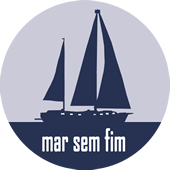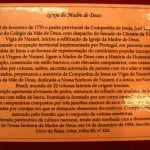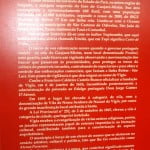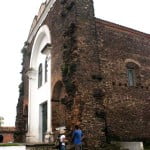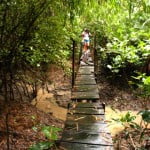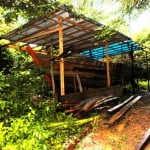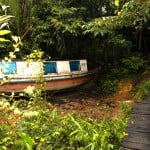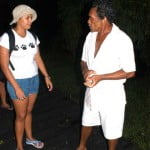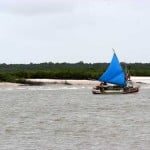17 – 04 – 2005, Sunday
During this stage of our journey, sailor and biologist Fernando Cerdeira, and film maker Paulo Cezar Cardoso joined the crew of the Endless Sea. They were unable to see the third episode of the series by TV Cultura seeing that our flight to Belém was leaving São Paulo at the same time: Sunday at 5.40 p.m. When I arrived at the airport, one hour before departure time, the members of the crew were talking about that and feeling a bit anguished. After all, we were enthusiastic about the possibility of seeing the results of our work every week. I calmed them down by telling them I had brought a DVD with a copy of the last edited programs, the third and the fourth ones, and that we could see them on board, on one of the evenings of the journey. Our plane took off right on time. An hour and a half later we were landing in Brasilia. We took another plane and a few minutes later we were taking off to Belém. After a two-hour flight we landed again. We picked up our luggage, a lot of pieces, including all the equipment, took a taxi and went to the Naval Base where tireless executive officer Alonso Góes was waiting for us. The Endless Sea was anchored at the “Patromotoria” of the Naval Base, thanks to our fellows from the Brazilian Navy that support our journey. Thank you Admiral Marcus Vinícius from the Fourth Naval District who is in charge of the Base. Thank you Commander Renato Paes from the Admiral’s general staff. We are helped and reassured by his support. In the boat, we had an exciting conversation about this new part of the journey as well as about our too many tasks of the following day. Early in the morning we were going to shoot some historical buildings of the extremely beautiful city of Belém, founded in 1611. At half past midday, I was going to have lunch with the Admiral and his team to thank them for all the support. After that, we were going shopping in a local supermarket and at 5 p.m. we had to be at Emilio Goeldi’s campus for a new interview with researcher Amílcar Mendes, who studies the occupation of the coast in this area. It was too much work. Better to go to bed early.
18 – 04 – 2005 Monday
At 7 a.m. Alonso woke us up and breakfast was ready. Before 8 a.m., we were out to shoot our first takes. We shot again the take in front of Teatro da Paz, an elegant building that witnesses the vitality of the golden age of the rubber extraction. Then we went to the place where the city started, alongside the Pará river, a neighborhood known today as Feliz Lusitânia, where Forte do Castelo (The Castle Fort) is, and the impressive Catedral da Sé (Sé Cathedral), with two towers projecting themselves upwards and forwards as if they were separated from the rest of the building. It is magnificent. This powerful architecture emphasized by the immaculate white painting contrasts with the blue sky and the dark green of the huge, centennial mango-trees around, it is very imposing. It is breathtaking, like everything in the Amazon, it is difficult to find adjectives to describe it. I left Paulina and Cardoso who were going to shoot other buildings and I went back to the boat to have a shower. It is quite hot here. Then I got dressed to have lunch with people from the Navy. I was at the door of the Fourth District where Admiral Marcus Vinicius and his team work. We almost got in together since he had just left a session at the Chamber of Deputies. I watched his entrance in the building with all the pomp and ceremony of that Force. Beautiful images. As he left the car, the Admiral was greeted by a small group of soldiers standing at attention as if there was a tunnel formed by people. A long and respectful salute from the Admiral towards another officer who was at the other end of the tunnel. This was the greeting exchanged at the sound of the traditional whistles used by the Navy warning the garrison about the arrival of the superior. We had a nice lunch, we talked about the sea, about the distant relationship the Brazilians have with the oceans and about the Endless Sea Project. At 2:30 p.m., I was back in the boat. I had to meet Fernando and go to the supermarket. Supplying the boat with fuel is troublesome. It is always the same and tiresome. While we were buying food, the taxi driver fetched Paulina and Cardoso from a restaurant. Then we were together again and went to Museu Goeldi in order to interview Amílcar one more time. It is amazing how easy it is for him to explain why there are hollows in Maranhão, as well as the details we were going to find in every stage of our journey to São Luis. The south coast of Pará and that of northern Maranhão are known as the only ones in Brazil that are formed by rivers that flow into other small bays surrounded by promontories. A little bit further on there is another river that flows into another bay which is also surrounded by a promontory, thus successively, one after the other, from Marapanim, near Belém, until, let’s say, the capital of Maranhão. This area is called “Hollows” because that’s how they look like, there are sea “hollows” in each one of these bays, as if the sea pushed the waters into the land. And the phenomenon that gave origin to this design was a movement of marine regression that occurred about seven thousand years ago, when the sea advanced towards the continent and “drowned” all the rivers of the area, forming this unusual aspect of the coast. We talked until 7 p.m. then we went back to the sailboat exhausted.
19 – 04 – 2005, Tuesday
It was completely dark when I was woken up by the noise of the motor of the Endless Sea. At first, I turned to the other side to sleep some extra minutes. In the coziness of the cabin, I could hear Alonso and Fernando talking. They were casting off. I waited in bed until the sailboat started to move, then I got up. As usual, coffee was ready in the thermos bottle. I had a cup of coffee and went to the cockpit. The Endless Sea was at cruising speed, with the prow towards the sea, many miles ahead. Two hours later we were going to arrive at Icoraci, on the west side of the promontory at the east end of Belém. We had to supply the boat with diesel before going on. At seven, after having fuelled up , we were navigating again. The wind was blowing east, but weakly as usual in the morning. I was a bit anguished because we were leaving behind the heart of the Amazon, after having navigated in that area since the beginning of the journey, when we left Oiapoque, in December, to Macapá. Then we crossed all the delta of that huge river until Belém. We had also been to Marajó, and now we were going to the sea again. Were we able to show how rich and complex this area is, though superficially, of course. The Amazon means immensity, extraordinary richness, a great variety of ecosystems and living beings, either those that live by the river and the “forest people”, or plants with an enormous and still unknown genetic inheritance, with several pharmacological properties, or mammals, reptiles, birds, insects or fishes. Whatever. What matters here is that everything is huge, different, difficult. This area goes from the Atlantic ocean until the Andes’ slopes. The Amazon river spans the equator and it has arms in both hemispheres, that is why there is abundant water from all possible sides. From the top, through the rain, from the west through the Andes’ thawing. At the east end, there is the strength of the Atlantic Ocean whose tide has already advanced 400 kilometers into the lowlands. Additionally, in the south through the rivers of the right bank, and in the north through the arms of the left side. It rains in the southern hemisphere in summer. This makes the volume of the waters of the arms of this side of the rivers bigger. In the northern hemisphere, it rains in the winter, making again the volume of the water of the arms of this side bigger. Thus, all over the year, the Amazon river receives a great volume of water permanently. This is the reason why this river throws into the ocean one fifth of the world’s fresh water. But there is more. Besides being the world’s biggest humid forest, the Amazon has savannas, white sand meadows, lowlands and highlands as well as groves of babassu palms. This is absolutely immense and that’s the reason why it is so difficult to know and to study it. These were the thoughts that crossed my mind as we were navigating out of it, hoping that the programs we have made so far show, though very slightly, all this greatness.
Then I remembered several books I read to prepare the programs and one of them came to my mind: Um Paraíso Perdido – Ensaios Amazônicos” (A Lost Paradise – Amazonic Essays) by Euclides da Cunha. I remembered this one because of the respect, admiration and humility expressed by the author when he talks about this area. He created the expression “Inferno Verde” (Green Hell) when he refers to the Amazon, but Euclides da Cunha went farther and said: “To see it one must abdicate to reveal it”. With the following conclusion: “Triumph will result from uncountable work in a very distant future. It is true, the Amazon is the last page to be written in the Genesis”. Only someone with his background could put the thing in these terms. As far as I am concerned, I leave this place with a deep feeling of humility, seeing the very little knowledge gained as a tiny, very little indeed, grain of sand. Thus, after having thought a lot about it, I could eventually concentrate on the trip until Vigia. The weather was cloudy and the wind started to blow more strongly, when we arrived at the mouth of the Guajará-Mirim river, an arm of the Pará river, through which we would arrive in the city. We had hardly arrived at the mouth and the depth started to diminish dangerously because of the obstruction of the rivers in this area. Their vegetal cover was cut to make cattle pastures possible… The result is always the same: the depth is lower and lower and it is dangerous to navigate. This is how the keel touched lightly the bottom of the river, then we turned and went towards the sea and waited until we found two fishing boats, quite big, going back to Vigia. Bingo! There is nothing better than having a pilot at our disposal. Especially under very heavy rain, and our visibility could hardly reach a mile ahead. We followed both, right behind them and entered easily and arrived in front of the village where we anchored. Lunch was served, it was 3.30 p.m. We had a very good meal and went to the city to choose the place we wanted to shoot, not today, tomorrow, since today there wasn’t enough light, it was almost impossible to register any images. Before getting off, we received a cell phone call from Fernando Sampaio from VTF, the production agency I hired. He gave us two updates, the first one was about the tapes we had sent him with images from Belém and according to him they were great.
And the second one: “habemos papa”. (We have a new pope).
20 – 04 – 2005, Wednesday
Today, early in the morning, we went to Vigia, a city with approximately 50 thousand inhabitants, a frantic city, with a big fleet, where there are some well preserved old buildings. The economy depends on non industrial and industrial fishing as well as on crab catching in mangrove areas around the city and on cattle raising. The city is relatively clean, though there is no basic sanitation. Once more, the waste goes straight to the river… and there is some dirt at the beaches because of the mud coming from the main street that goes to the river. Here we have again a population, like all the others we have visited so far, with enormous gaps in their basic education and there is lack of information as far as public cleanliness and preservation are concerned. When they stop their boats by the river banks, in front of the city, they throw all kinds of dirt, leftovers and old piles, plastic bags, etc. They don’t realize that by doing so, they are killing sea life, thus making their life even more difficult, hard and complicated, especially because their survival depends on the biodiversity of the area where they live. It is a pity to see so many good people abandoned like this by the government. And Pará had two good administrations with Almir Gabriel. He was able to elect his successor, Adibe Jatene, and helped to bury the local Paulo Salim Maluf politician species, that is, Jader Barbalho… At least, this was the feeling we had after several trips, observing and talking to many people from Pará. Vigia is quite old, some historians say it was probably founded some days before the foundation of Belém, in 1611. The city has history and some important public figures. Francisco Palheta was born here, the man who went to Guyana to defend Brazilian interests and when he came back he brought in his luggage some coffee seeds that ended by propelling the Brazilian economy many years later. In Vigia, there is also the Catedral Madre de Deus (Mother of God Cathedral), built by Jesuits in 1734, the purest baroque style. The huge building is a church and a school, and it is very well preserved. It is a pity to see that some slums were built on the river banks, sorts of palafittes, that block the view of those like us arriving through the river. There is another church of the same period, built with stones by Jesuits, with extremely thick walls, imposing but unfinished. Many years later, in the thirties during the 20th century, it was finished, but the original architecture was not respected, resulting in a hybrid style, modern, of a doubtful taste. But walking in the city, it is possible to see here and there some buildings from the 17th and 18th centuries, with façades full of Portuguese tiles and sophisticated details such as china pine cones in porches. I enjoyed what I saw. After shooting and visiting, we came to the boat to have lunch. After lunch, we had our last visit before leaving, we went to Quilombo do Cacau. It is a small community, descendents from slaves brought by Barão do Guajará in the 19th century who live far in the forest. We landed on a small floating bridge at the river bank and walked almost a kilometer on narrow wood boards that are attached over weak pillars stuck in the mangrove area. It is a swamp area, but the community lives inside the forest, in a drier place. That is the only possible way to reach them, walking on those boards. It was very hard for me, especially because I had forgotten my tennis shoes in the sailboat, and I realized that when I left the rubber boat and saw those narrow wood boards suspended sometimes two meters above the floor and wet because of the strong rain that had fallen all day long. But it was worthwhile, my balance was good and even barefoot I didn’t fall and had a very nice walk through the forest. From there we went back to our floating house. The crew got off the boat to have a bath. I stayed on board and had my bath here, since the skipper has some privileges. Then I sat at the plotting table, my laptop was turned on, and I started to write today’s logbook. I was almost eaten by carapanãs (mosquitoes) , in spite of that I was able to write about what happened today. Tomorrow, we will leave at 5 a.m. to the Island of Guarás (Flamingoes), 36 miles northwards, where there is an important flock of these birds, listed by Ibama under the words “threatened with extinction”. See you there.
21 – 04 – 2005, Thursday
We left Vigia at 6 a.m., it was still dark. The bearing was 50 degrees and our horizon was quite heavy. We were going to navigate for 6 hours to cover the 36 miles that separated us from the island. I followed the departure of the boat by the mouth of Guajará-Mirim, it is the toughest part due to a very low depth. During that moment of the morning there was high tide and we had no problems. I was up for a while and when I realized the boat was on the right way and with no problems ahead, I relaxed and went to bed again. One of the good things in a cruise is the fact of not having many obligations, leaving a place and arriving somewhere else on a single day is enough. The rest of the routine you do it yourself. Reading a good book, listening to music, admiring the landscape, putting things that were messy in order, sleeping during the day, cooking, eating… these are some of the possibilities. And you decide what to do. There are no appointments with people outside, so feeling free and deciding things by yourself make you enjoy this great liberty. In that situation, I decided to go back to bed and slept deeply. I couldn’t even feel the wind blowing strongly and the water from the sea sprinkling on the sailboat hull. And that happened quite often. When I woke up, we were about to arrive, I was told that when the tide changes, at 9.30 a.m., the north-eastern wind reached the speed of 40 knots, which is significant. Everybody was wearing raincoats, which were wet, and was exhausted because of the hard journey whereas I was feeling completely relaxed, after having slept the whole morning in the cabin. Wonderful! The island of Guarás is virgin and beautiful, it is surrounded by beaches of white sand that can be seen at low tide, there are also rivers inside and mangroves. And of course flocks of flamingoes with their typical red color as well as white and blue herons and many other types of birds.
As soon as we arrived, Cardozo and I took the rubber boat and the stern motor and went up one of the rivers that goes inside the island. It is a beautiful landscape. There are beautiful mangroves, huge trees, shrimps scared with the noise of the motor alongside the stern of the boat, on the surface of the water zigzagging like chickens on country roads. When we were coming back, at sunset, we were able to shoot flocks of flamingoes that at this time gather together on the crowns of the trees to spend the night. It was a perfect day. When we were back to our haven, the Endless Sea, we watched on the cockpit episodes 3 and 4 of the series we are making for TV. It is marvelous to see it here, on the laptop screen outside, the DVDs of the program. It is a perfect movie-theater and then bed.
22 – 04 – 2005, Friday
We woke up early, as usual, and waited for the rain to stop. This was the first time it rained most of the time during our journey. Since we left, it has rained most of the time. It is stronger in the afternoon, after 2 p.m. First the horizon gets dark, with very dark clouds. Then, the wind blows strongly and the clouds start to surround us, threatening us here and there, and sometimes precipitation starts far from us. But when we think today we won’t be reached by the clouds, then they come, right above us, very powerful and accurate, and start discharging tons of water over us. This happens everyday.
By the end of the afternoon, there is very strong rain and wind, but the whole thing takes no longer than an hour.
Sometimes, it is the same during the night, and sometimes, during the following morning too, like today. We had breakfast on the cockpit of the boat from where we could see flocks of flamingoes on the crowns of the trees while it was raining.
We were waiting to have a clearer day to shoot again. But before we could even move, day dawned and the flamingoes flew away, whereas, in our laziness, we were still deciding what to do. The previous day, Cardozo, the film maker of this part of the journey, and I had already entered in one of the channels, navigating until it was deep enough. We shot beaches, forests, flamingoes and a few caboclos’ houses we had seen on the island. Then we decided to go straight to Algodoal island, 30 miles away. It was a five-hour trip, calm all the way except the arrival. As usual, it was around 2 or 3 p.m. and reaching Algodoal was quite difficult because it is not deep enough. There are waves from everywhere, it is not possible to see the passage on the nautical map because it was done 20 years ago and the sand banks change and at that time there are dark clouds in the sky announcing strong rain and wind very soon. Many fishing boats were around, but none was entering at that specific moment. They were all fishing. I called on the VHF radio, asking if any of them could help me go into the estuary, but nothing. Then I decided to anchor beside one of them and wait until it decided to enter.
That’s what we did. After all this trouble, I slept on one of the cockpit benches and waited until Alonso woke me up and told me the fishing boat was lifting the anchor. We lifted ours and followed the fishing boat under the rain until we reached the beach in front of the village on Algodoal island, where we dropped our anchor again. Algodoal made me think of paradise. The island is near the continent and this is the reason why it is not affected by the strong and rude climatic consequences like the ones that affect oceanic islands. That’s why even if there is a hurricane this is a good shelter for boats. We stopped in front of the main beach, the village was built behind it. There are many trees and the houses are not higher than the crowns of the trees, which makes the landscape similar to that found by the first settlers. Electricity arrived last year and the inhabitants only wanted their houses lighted up, not the streets. The beaches look virgin, in spite of the presence of the city behind, and the lack of sanitation doesn’t worry much since the number of inhabitants is small. It is not difficult to see that again economy here depends on fishing, non industrial fishing. There are no company ships here or big boats, only the typical local fishing boats , and many sail-canoes carefully painted with many colors, with “pé de galinha ” (chicken feet) prows, low masts, bright color sails and huge rudders. It is beautiful to see how easily caboclos handle the boats. They show they are in their natural element. Sails are easily opened and closed. They sail against the wind naturally, just leaning part of their body out of the hull to counterbalance and when they navigate helped by the wind they reach high speed. Every half an hour, there is one of these canoes coming or going to the sea. And since our sailboat always attracts people’s attention, some of them pass by a few meters away from us. We can see how skillful these natural sailors are without too much effort. I took excellent pictures of them, sitting on the cockpit of the Endless Sea. This is another Brazil’s maritime aspect which is not enough studied, known or appreciated: the diversity of the typical boats whose building secrets are transmitted from father to son through generations. There are no drafts, graphs or difficult figures. Only the centennial tradition. But eventually, the result is always operational, practical and adapted to local navigation conditions, either for fishing, or for transporting goods or passengers. It is amazing to see this tradition alive, especially here in northern Brazil in the 21st century. I hope they continue because it is a cultural good as well as music, cooking and typical dances that represent a significant part of the Brazilian artistic culture and patrimony. However, they deserve to be well studied, more official support, maybe including regattas in the tourist calendar of different cities of the river banks in order to help the self-esteem of many builders and beneficiaries, thus helping to preserve and encourage this art that is threatened today. On one side there is “progress” that make us see sailboats suspiciously , on the other, there are the silly restrictions from Ibama that says that it is illegal to cut trees to build them. And as time goes by, for one reason or the other, fewer and fewer are seen. It is unbelievable how little the average Brazilian as well as local authorities, or even educated people know about Brazil’s maritime tradition. Believe it or not, we are a maritime Nation. We were discovered by Portuguese sailors, fruit of an extraordinary epic journey, seen by some historians, as one of the most monumental of Human History. Our country has one of the planet’s largest coastal zones, with approximately 8500 kilometers. During the first 200 years, after the discovery, most of our predecessors lived on the shore due to great difficulties resulting from dense forests, or even the Sea mountain chain, that refrain the Portuguese from entering in the countryside. That’s probably why we developed the ability of building many types of boats ranging from paddle rafts, even the ones having two sails, cutters from Maranhão, lighters from Bahia, quarterdeck canoes from São Francisco, upperdeck canoes from Laguna, to vigilengas (round fishing canoes) from here in northern Brazil. There are many different types having Portuguese, Indian, Dutch, African and so many other influences. It is a pity to know that this is disappearing day after day and nobody knows their importance and tradition. Fortunately, we have here in Brazil Museu do Mar (the Sea Museum) in São Francisco do Sul, in Santa Catarina.
This is the result of intelligent, sensitive and entrepreneurial work of Brazilians such as Dalmo de Abreu Silva, who dignified the Museum having today a beautiful collection with dozens of different boats and canoes from the whole country. It is beautiful and a conquest that should be well known. Well, in the afternoon, after resting from the trip, we went out to shoot, as usual. While Paulina and Cardozo were shooting the village, Cerdeira and I tried a short cut near the mangrove banks. But we weren’t very lucky. Later on, our fellows who had gone out to shoot were already back because it was late and it was getting dark. Time to go to the boat, eat and sleep.
23 – 04 – 2005, Saturday
After breakfast, we took the rubber boat and landed. As we were walking on the island, we met a fisherman, Zezinho, who we started to talk to. We were talking about their daily life and he mentioned Lagoa da Princesa (the Princess Lagoon) and we decided to visit it. It is behind the dunes of the beach with the same name, the only place in the island where there is fresh water. We rented a small paddle boat from him and went to a channel known as “furo velho” (old hole). On our way, we could see groups of monkeys, many kinds of birds such as White and Blue Herons, Curlews, Peacocks from Pará, and many Kingfishers. We stopped near the bank, landed and started to walk through a track in the middle of the mangrove towards the lagoon. From the mangrove vegetation we went to the shoal, then again through the forest until we arrived there. It was a quite small lagoon of black waters and deep enough surrounded by white dunes. Wonderful. But even more wonderful was the refreshing bath we had and our talk with Zezinho and his son who followed us. Some hours later, we were back. In Algodoal, we met some tourists and among them there was someone from Minas, a musician, who played the harmonica and the guitar, with whom we exchanged some words in the local bar where people play and dance carimbó (a typical dance from Pará). After that, we went back to the boat but we stopped before at Junior’s store, a local craftsman and very nice person who charmed by the Endless Sea drew our sail-boat on a tee-shirt and gave it to us as a present. But a gift that caused trouble because since then we have been fighting on board to decide who is going to keep it… And that was enough for one day. We were so tired that we couldn’t go to the carimbó place at 10 p.m. In fact, long before that time we could hear a symphony of heavy snores on board of the Endless Sea.
24 – 04 – 2005, Sunday
At 6 a.m. tide was at its highest peak, the right time to start our trip to Maracanã. We were going to navigate three miles alongside the West coast of Algodoal island until Mocooca channel, in the south, which he had to cross. These “channels” are found everywhere in the Amazon. They are narrow channels, usually deep, that go from one area to the other.
After having navigated some miles, we left the east side of Algodoal in front of the village of Mocooca. Here we had a serious problem. As I said, electricity was introduced here less than a year ago and the high tension wires cross the channel, right at that point, in front of the village of Mocooca. When we first tried to go below the wires, the edge of the mast touched the wires and many sparks resulted from that and it scorched the prow sail. We retreated immediately after forcing heavily the reversing gear. We then tried through the continent side where apparently the lamppost was higher. Under the attentive eyes of the crowd gathered in a bar next to the local pier, we were able to cross without touching the wires. What a relief! Getting an electric shock of such wires would have toasted any of us in seconds, not to mention the loss of the electric equipment on board. Fortunately, when the sail touched the wires, only the cloth touched them not the metal part. We were safe from that harm. There was another difficulty to be faced, the dangerous navigation through an area which is not deep enough and not marked on nautical maps until the end of this “hollow” of the coast of Pará where the village of Maracanã is. We navigated for some hours under intense heat and passed by small sailboats until we reached a high steep on the bank of Maracanã river, due to strong erosion caused by the vegetal cover that was removed and lots of rain, behind which was the drowsy village of Maracanã. As soon as we anchored we noticed that most children from the village had run to the river bank to see our boat. Yippee, the circus is here! This might be the feeling they have, since they live here isolated from places where there is more life and movement.
It didn’t take too long until the first child jumped into the water and swam to the boat. Then came the others. Two, maybe three dozen of them, crazy about that novelty. It was hard to keep them in the water, we had just cleaned everything up on board, it was messy and there was some dirt, as usual, after a long trip.
But we succeeded, thanks to Paulina who tried to convince them that it wasn’t the right time to come on board. Later, after the cleaning up, we went to the village to visit and shoot. What a disaster! Nothing special, just a few historical buildings falling apart. Nothing to do with Vigia, and not a single soul in the streets. It was Sunday, everybody was probably at home watching TV. I could hear the sound from many TV sets as I was passing by the closed houses. But worse than this atmosphere as if time had stopped was the abandoned and deteriorated aspect of the buildings. It is “stretched” everywhere. They are brick constructions and as time goes by new parts are added, they have no style, they are ugly and trivial. There wasn’t much to do. We’d better leave and sleep on our way out to the sea and gain some time seeing that our trip tomorrow towards Bragança will be long, last city on the coast of Pará. After that, we will be navigating in Maranhão’s waters.
25 – 04 – 2005, Monday
Last night, we slept in the middle of the canal off the Maracanã bay, right in the middle of it. It was the best we could have since navigation means are scarce around here, especially at night. Therefore, there was nothing to fear. We picked a spot that was deep enough even at low tide and set anchor. By dusk the following morning we had already been sailing, because we still had 80 miles to go in order to get to the Caetés bay. Not to mention another 20 miles we had to cover up the Caetés river all the way to Bragança. It was a smooth journey. For the very first time the sea was as smooth as a breeze, as they say. No breaking waves or wind.
Things began to get rougher as we approached the river mouth, around 2 p.m.
The river mouths around here are often jilted up due to land clearing and deforestation effects. Sediments are washed off towards the sea by the river waters. However, they are stopped by the counter tides as they reach shore, and therefore cannot move forward. As a result, river mouths are always shallow, the Caetés mouth being the shallowest of all.
Luckily there was no wind or waves – otherwise, we wouldn’t have managed to move in. Still a long way from the river mouth, we were already touching the keel down in the deep mud. We decided to look for a fishing boat that was moving inwards. We found “Missão Fortaleza”. I radioed her stuttering skipper and asked him to give us a ride into the river. He promptly responded to our request, proving to be a true sailor, who abides the sea’s millenary traditions, such as the duty to help newcomers or boats in danger. “Missão Fortaleza” slowed down right away .They waited till we got closer, and then proceeded into the river mouth. Once again, we experienced moments of great tension. We were not on deep enough waters even though high tide had started two hours before. The deepest the waters could get was 3 meters, being as shallow as 2 meters at the beginning, whereas our keel is 1,80 long. We ended up plowing the sea several times with the tip of our keel. Luckily, as I said, the sea ground was 100% flat, otherwise I would have aborted the move. The first hour was critical. Our boat kept literally sloping up and down. Things got easier after we were back on 3-meters-deep waters. As we approached the mouth of the river, we were surprised by the great number of colorful sail boats – there were so many of them they looked like a regatta. Closer to the shore, flocks of “guarás” would take flight off the trees, crossing the sky above us. These two scenes alone already made our move worth it.
Later on, as we went up the river, we noticed the river got narrower and narrower, until it was only around 30 meters wide, so we were able to look at both sides attentively. A beautiful forest, full of mangroves, surrounds the Caetés shores. After a few hours moving on slowly, we got to the Bacuriteua village, which we had mistaken for Bragança, although it turned out to be a just a quiet little town. We decided to cast anchor right there, though, for it was getting late, and the sun was just about to set. “Missão Fortaleza” was there, anchored beside a diesel pump and near an ice factory. It was all we needed. We set anchor, had dinner and then went to sleep.
26 – 04 – 2005, Tuesday
Early in the morning we paid a visit to “Missão Fortaleza” to thank them for their support. Surprisingly, the skipper didn’t stutter as much in person as he did on the radio. He was nice enough to treat us with fresh fish and a huge ice bag, since we were running out of ice. After that, in order to continue our journey to Bragança, we went back to “Endless Sea”, which was anchored only a few meters up the river. At this point, low tide began to drain out quickly, I mean, very quickly! In a split second, our anchor came off, and the boat began to drift down the river dangerously. Luckily, everyone was onboard. After strenuous work , we managed to pull the 35-kilo anchor and its chain back up without having to use the tugboat. Then, I set the engine to cruising speed: 1500 RPMs on a 90-HP engine, which at normal circumstances will push the boat at 7.5 knots. However, as we were pushing against an outrageously low tide, our boat was moving at less than 1 knot. Therefore, it took us almost an hour and a half to do one last mile to Bragança. Tides have an amazing power, especially when the moon is out, as is the case in the north region now. Brutish water avalanches go up or down the river depending on the course of the tides.
After lots of hardship, we arrived in Bragança at 1:30pm. This time, finally, the size of the town could be easily spotted after we made our last curve. It was in accordance with the town’s population – estimated at around100.000 people. We could see the port from far away, lying on the river shore, lined up by dozens of big fishing boats stuck on the border, as is the custom around here. From behind them stood the town, right above a small hill.
We could see some big houses, whose roofs were typical of properties in old towns. And traffic sure was busy! There were cars and trucks driving back and forth, and lots of people at the port. We set anchor before getting to the first buildings, got some rest and then got ourselves ready to get off the boat.
A little while later, we had managed to unload all our equipment on the shore. There were lots of people at the port. Fishermen, sailors, mechanics, and street vendors moved around. We could also smell the stench of the fish and, of course, the garbage piled up near the boats stuck in the mud.
We had hardly started our sightseeing when we got to a beautiful square. It was full of royal palms and it had a bandstand in its center – one of those iron-made bandstands shipped from England at the early twentieth century which had been set up here, incidentally just as the iron structure at the “Ver-o-peso” market in Belém.
Behind the bandstand was the nice-looking City Hall building. Recently renovated, both buildings were painted in a tone of ocher and had white details.
After doing the necessary shooting, we tried to contact the Secretary of Tourism as well as the Secretary of Culture, but to our disappointment, we were told that the City Hall team worked part-time –mornings only. To be helped in the afternoon, “only if we went to their place” , said the workers who happened to be there then.
What a shame. Too bad we didn’t have a “Deadpan” trophy with us, the so-called “losers’ Oscar, for these folks around here sure deserve one.
We continued wandering around the town, which is kept in reasonably good shape, is quite clean, and whose majority of historical buildings are well-preserved. We filmed the XIX Century churches, the Episcopal Palace, a pompous construction resembling the ones in Moorish Spain, and which was the Bishop of Bragança’s residence, besides a few other outstanding buildings such as a big house known as the Thirteen-Window House, formerly owned by a local baron, and so on.
After having filmed the major buildings in town, we took a cab to Ajureteuna, the town’s most famous beach, 40 minutes away from downtown. The paved road that took us to the beach was the worst ever. It had holes everywhere, no shoulders, and its signaling system was atrocious, to say the least. This is to say we’re talking about one of the “most famous” tourism spots on the Pará coast.
Ajureteuna is huge and boring. It is a long , bare and waveless beach, more than 5-kilometers wide. As usual, it had absolutely no tourism infra-structure. There were two boarding houses which I wouldn’t recommend even to my worst enemy. They were cheap, dirty and very uncomfortable – really ugly. It’s amazing how little is done about tourism in the northern region. I’ve mentioned this in previous chapters, but I’ll mention it again. Everywhere we’ve been, there is no infra-structure to meet the demands of these towns and their natural resources. Belém, the gateway to the Amazon, is a primary example. It has only one 5-star Hilton hotel, and almost no other decent hotels, such as hotels geared to ecologic tourism, for example “jungle hotels”.
Brazil’s vocation for tourism is more than evident, and our excellent natural resources for ecologic tourism are even more outstanding, such as the northeast beaches, the “Pantanal” swamps, and of course the Amazon. I’ve mentioned last year’s issue of the world’s incredible turnover of ecologic tourism: $260 billion dollars. Nevertheless, Brazil is counted out of this money snowball because its towns are dirty and unsafe. Their systems of traffic signs are inefficient and they have almost no infra-structure to offer to demanding American, European or Asian tourists, who end up choosing Africa, Argentina or Oceanic countries.
I had access to some of Pará’s official data on tourism. They say that, until 2002, only 0,34% of the foreign tourists in Brazil chose to visit Pará.
That’s quite understandable. Some important public squares, such as the “Teatro da Paz” square, one of the city’s impressive postcards, whose theater resembles the “Scalla” in Milan, exhales urine stench that not even noses used to the Brazilian smell, like mine, can bear, let alone foreign tourists, who have made clear that they may be willing to put up with the violence, but not with the filthiness.
On top of the filth there is the lack of hotels and special programs geared to non-professional fishing, for instance. In the USA, licenses for non-professional fishermen alone represent close to a 100-billion-dollar yearly turnover, with whose funds they run and renovate public parks, or invest in infra-structure accommodation, boats, inspectors’ wages, etc. Since Brazil lacks this kind of infra-structure, foreign tourists wind up in Argentina, where they spend some of their cash fishing trout in Patagonia on their vacation. The Amazon could easily be those people’s manna, with its twenty thousand kilometers of navigable rivers all year long and over three thousand fish species. Had it the infra-structure, it would be. But besides that, tourists who venture throughout Brazil also have to endure the worst roads one has heard of: they get nowhere, have no traffic signs system and holes everywhere. Obviously, tourists will sure use up their dollars in Argentina, Kenya ,Tanzania, South Africa, etc.
Those who rule Brazil would rather keep things as is, avoiding responsibility, instead of looking into public policies for non-professional fishing or hunting and ecologic tourism. After all, Brazil is such a well-off country it doesn’t need any extra funds….., or does it? I wonder if I’m just being too critical.
Well, feeling kind of turned off one more time by the way things stand – pretty much the same in every town we’ve been to so far – we went back to the boat to have dinner and go to bed. Tomorrow we’ll be visiting the Canelas island on the river estuary, and then head to São Luis do Maranhão.
27 – 04 – 2005, Wednesday
We woke up early, though not very early. It turned out we had to get some ice and diesel, and the gas-station only opened at 7a.m. So we were able to sleep in today. We finally got our supplies and moved forward.
We had been sailing for merely one hour down the Caetés river when the alarm went off. The engine’s oil pressure was dropping, and whenever that happens, it is usually caused by a leak. In a split second Alonso had plunged himself into the engine room, trying to figure out the problem. It didn’t take him long to come back out ,covered with grease, as usual, but with the perfect diagnosis: a retainer in the front part of the engine had blown out, and there was no way it could be repaired onboard. We’d have to go back. Fortunately, there are hundreds of fishing boats around here, and wherever there are boats there are mechanics. We resorted to our friends on “Missão Fortaleza”, who promptly recommended someone. Besides the name of a good mechanic, they gave us a taxi driver’s number, so that we were able to call the cab from the boat and have him bring the mechanic onboard.
Right now, at twelve-thirty p.m., I’m writing this journal while waiting for him. It doesn’t look like a big deal. We’ll see.
While we’re waiting, let me talk a bit more about Brazilians’ navigation talents.
The other day in Algodoal, I was talking about that. I get upset about how so few people acknowledge this one more talent that Brazilians have. However, as I was reading Joshua Slocum’s book onboard yesterday, “A Viagem do Liberdade” (“Liberdade’s Journey”), in which he narrates his adventure on the Brazilian coast, I was pleasantly surprised by what I read. Slocum was one of the most outstanding seamen of modern times, the author of a classical work of nautical literature, ”A Viagem do Spray” (“Spray’s Journey”), in which he narrates the first voyage around the world, a solitary one, on a small sailboat, in the late XIX Century. There is not one single seaman who does not know about this book here, in Europe, Asia, or the USA. Slocum became a legend after this book was published and translated into dozens of languages. In a nutshell, he was a sailing vessel skipper who couldn’t get used to the advent of coal and who all of a sudden found himself useless, since he was used to the old art of navigation , which took advantage of both winds and currents. So he built “Spray” and went all over the world, writing the classical book I’ve mentioned previously.
Now, another book of his has just come out in Brazil, “Liberdade’s Journey”, where he narrates his misfortunes with his Cliper, Aquidneck, on his journeys to Brazil in the late XIX Century.
With his second wife and two children from his first marriage onboard, Slocum narrates his travels to Brazil, Argentina and Uruguay shipping goods back and forth, handling mutiny, using Brazilian sailors, until he had an accident in Antonina, near Paranaguá, where he lost his boat.
He decided to build a small sailboat, using Brazilian canoes and Cape Ann’s boats as models. It was a 35-feet boat mounted in sampan and 100% built with Atlantic forest wood which he himself chose, molded and used. It is a classical of nautical literature, now translated into Portuguese. What is even more important is the fact that, having a worldwide reputation for his nautical accomplishments, this is what he said about Brazilians and their vessels:
“These canoes, sometimes made out of gigantic trees, are skillfully molded and carved. They are the family’s coach and cart to get to land, or carry rice into the windmill. Roads are often unheard of wherever there are canoes. As a result, men and women are trained almost to perfection in the art of canoeing. “
Says the American seaman: “The family-size canoe cited previously can carry usually many tons and it is decorated with carvings all around its edge. From the biggest to the smallest ones, they are well-taken care of, like precious jewels, and are made to last many years. “ As to Brazilians’ skillfulness in the water , our skipper concludes: “ Most of the time during the year, the land and sea breeze pattern is usually the same on the coast, from Cabo Frio to Santa Catarina. Therefore, the almost amphibious coast dwellers, who love the water and manage it like ducks and born sailors do, take great advantage of navigation.”
This is to confirm what I stated above. I literally got goose bumps when I read that excerpt. Fernando Cerdeira was sitting beside me then, so I read Slocum’s statements aloud to him. We were both delighted that we now had such a great master, which emphatically corroborated with what we already acknowledged in our daily conversations. The next step is to help other Brazilians know about, respect and value this one more skill they have. As far as I’m concerned, I will make Joshua Slocum’s beautiful testimony public over and over, as many times as necessary.
Some day, hopefully, Brazilians will be able to look at the sea as something other than merely a leisure spot.
Back to our boat, we didn’t even have to wait for the mechanic. Alonso and Cerdeira ended up making the necessary amendments even though it turned out to be too late for us to leave, unfortunately.
28 – 04 –2005, Thursday
We left at sunrise, this time using the south bar instead of the north one to get out of the river estuary. We were pleasantly surprised to realize it was a lot deeper than the first bar. We never had less than a 5-meter depth, which meant we had started off well on our 200-mile journey to Maranhão.
Out there at open sea we had 15-20 knot northeast winds, which was ideal. After opening the bow sail (“genoa”) and having raised the master sail, we sailed the whole day and night – nothing else relevant happened that is worth registering.
It was a fine, smooth journey, in which we kept a steady 6-knot speed.
29 – 04 – 2005, Friday
Last night a “Pirajá” – a heavy cloud surrounded by strong winds – charged its due as it went past “Endless Sea” and ripped the bow sail, causing a big enough damage to stop us from using this sail until we get to São Luis. The rains that have been falling since last December, when the boat arrived at the “Oiapoque” river, have also made the sail canvas rot a little more, so the wind that night did not have to be too strong to rip the canvas…..
We rolled up the sail and continued the journey resorting to the master sail and the engine, moving slowing to keep to the speed.
Now, at 10:30 a.m., we are at the Lençois island slant, 90 miles off São Luis, where we should be arriving tonight. There’s a northeast wind, now a bit softer at its 13,15 knots. Other than that, lunch is guaranteed. As usual, Alonso dropped a line, and we’ve just caught a mackerel that is on the way to the table.
We sailed smoothly until midnight, when we cast anchor in front of the São Luis Yacht Club, at the end of the beach, where “Endless Sea” is now waiting for our next journey.
